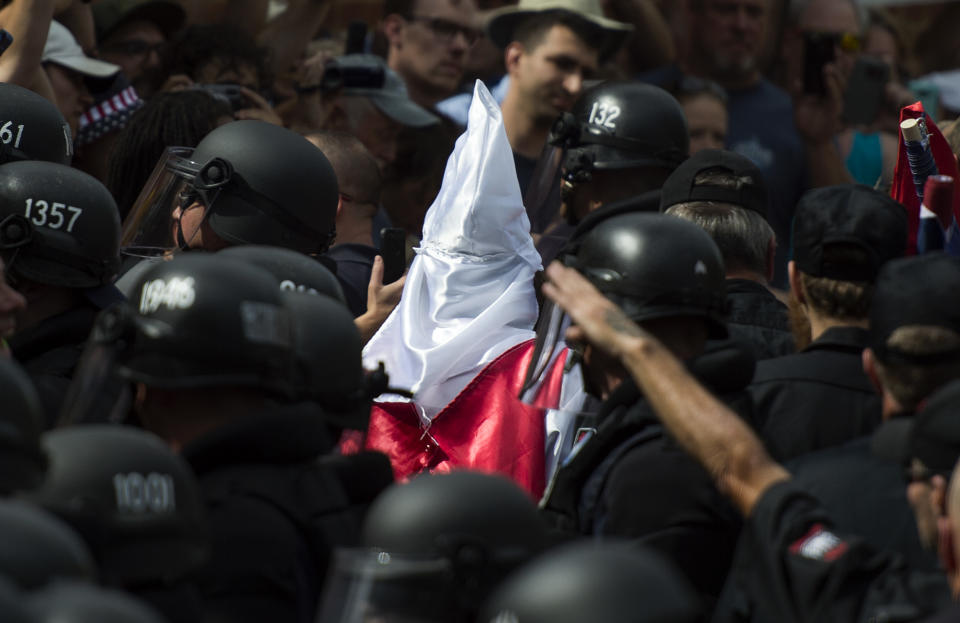Who are the far right groups on the march in America - and are they growing?

The world looked on, appalled, as torch-waving marchers walked through Charlottesville, Virginia last week, chanting, ‘Jews will not replace us.’
The events in the town turned to horror when James Fields – pictured marching with white supremacists – drove a car into a crowd of counter-protesters, killing one woman.
Donald Trump’s repeated refusal to condemn the marchers outright has turned the Charlottesville march into a global news story.
But who are the groups involved?
MOST POPULAR STORIES ON YAHOO UK:
Cyclist who hit pedestrian ‘shouted at her as she lay on the ground dying’
Kim Jong Un backs down as US warns: ‘This could escalate into war very quickly’
Manchester bombing ‘homeless hero’ Chris Parker charged with stealing bank card on night of attack
Donald Trump on ‘wrong side’ in fight against Nazis
How many such extremists are there – and is that number growing?
How many extremist groups are there in America?

The march in Charlottesville was billed as ‘Unite the Right’ – and aimed to bring several far-right groups together under one banner.
These included so-called ‘alt right’ activists, plus established far-right and neo-Nazi groups.
The numbers were relatively small, despite the global visibility of the events, with hundreds rather than thousands.
Far-right monitoring groups believe that between 500 and 1,000 far-right activists were due to attend, along with 30 prominent speakers.
America’s Southern Poverty Law Center (SPLC) says that it tracks more than 1,600 extremist groups in the country.
‘Alt right’

The ‘alt right’ has become the most heavily publicised group of American right-wingers – a loose coalition of online activists focused on ‘white identity’.
The movement’s most recognisable figurehead is Richard Spencer, an activist and journalist who claims to have popularised the use of the phrase ‘alt right’.
Trump's statement was fair and down to earth. #Charlottesville could have been peaceful, if police did its job. https://t.co/3FUgmWoiWi
— Richard ☝Spencer (@RichardBSpencer) August 15, 2017
The movement is difficult to quantify in terms of support, because many of its supporters are online, and express their activism in the form of memes and comments.
‘Alt right’ supporters describe themselves as in favour of freedom of speech and white identity – but have been blamed for racial harassment and the use of neo-Nazi imagery.
Vanguard America

The distinctive red-and-white logos of Vanguard America were highly visible at the Unite the Right rally.
The neo-Nazi group’s slogan, ‘Blood and soil’’ – referencing a Nazi one – was chanted widely at the march.
Alleged killer James Field was pictured with the group, although he is not thought to be a member.
The group’s leader is allegedly an American ex-serviceman, Dillon Hopper, 29, whose Facebook image shows Donald Trump building a wall.
Traditionalist Youth Network

Many disparate groups came together at the Unite the Right rally – and one of the key organisers was Matthew Heimbach, leader of Traditionalist Youth Network.
Traditionalist Youth Network is a white supremacist organisation which has partnered with self-described Aryan and KKK groups.
After the rally, Heimbach was recorded defending alleged killer James Fields.
Supporters of the defendant in #charlottesville speak out outside the courthouse pic.twitter.com/74l4lf19TP
— Andy Campbell (@AndyBCampbell) August 14, 2017
After the rally, Heimbach said, ‘We showed that our movement is not just online, but growing physically. We asserted ourselves as the voice of white America.’
Ku Klux Klan
While not a visible presence at the Charlottesville rally, the Ku Klux Klan were involved in earlier protests in July.
The veteran racist group is estimated to have between 5,000 and 8,000 members – and described a, ‘surge in membership across the Deep South’ last year’.
Ex-KKK leader David Duke – a former Imperial Wizard of the Ku Klux Klan – praised the events of the rally.
Thank you President Trump for your honesty & courage to tell the truth about #Charlottesville & condemn the leftist terrorists in BLM/Antifa https://t.co/tTESdV4LP0
— David Duke (@DrDavidDuke) August 15, 2017
Why Charlottesville was a huge victory and redpilll for millions of white Americans! https://t.co/ddqNLR80dO pic.twitter.com/VyEyV2lDOK
— David Duke (@DrDavidDuke) August 15, 2017
Militia
Chart of Patriot militias involved in #Charlottesville, via @MilitiaWatch: https://t.co/HjwZmFUsZr pic.twitter.com/oAA8StmUfN
— Hampton Stall هامبتن (@HamptonStall) August 14, 2017
Three Percenters (a very large, loose-knit militia org) has finally decided to distance themselves from the white supremacy crowd. pic.twitter.com/Vab3EZr1Hn
— JJ MacNab (@jjmacnab) August 14, 2017
Many of the most heavily armed activists in Charlottesville were members of militia – and were not actually there to support the marchers.
Militia units were instead there to ‘defend free speech’ – and one leader has since condemned the marchers as ‘rightwing lunatics’.
Under American law, citizens are allowed to form their own military units: ‘A well regulated Militia, being necessary to the security of a free State, the right of the people to keep and bear Arms, shall not be infringed.’

 Yahoo News
Yahoo News 

